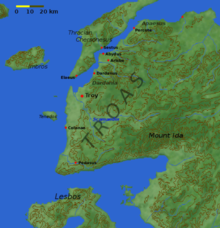Troy.
Troy (Ancient Greek: Τροία, Troia or Τροίας, Troias and Ἴλιον, Ilion or Ἴλιος, Ilios; Latin: Troia and Ilium;[note 1] Hittite: Wilusha or Truwisha;[1][2] Turkish: Truva or Troya) was a city situated in the far northwest of the region known in late Classical antiquity as Asia Minor, now known as Anatolia in modern Turkey, near (just south of) the southwest mouth of the Dardanelles strait and northwest of Mount Ida. The present-day location is known as Hisarlik. It was the setting of the Trojan War described in the Greek Epic Cycle, in particular in the Iliad, one of the two epic poems attributed to Homer. Metrical evidence from the Iliad and the Odyssey suggests that the name Ἴλιον (Ilion) formerly began with a digamma: Ϝίλιον (Wilson); this is also supported by the Hittite name for what is thought to be the same city, Wilusa.
A new capital called Ilium (from Greek: Ἴλιον, Ilion) was founded on the site in the reign of the Roman Emperor Augustus. It flourished until the establishment of Constantinople, became a bishopric and declined gradually in the Byzantine era, but is now a Latin Catholic titular see.
In 1865, English archaeologist Frank Calvert excavated trial trenches in a field he had bought from a local farmer at Hisarlik, and in 1868, Heinrich Schliemann, a wealthy German businessman and archaeologist, also began excavating in the area after a chance meeting with Calvert in Çanakkale.[3][4] These excavations revealed several cities built in succession. Schliemann was at first sceptical about the identification of Hisarlik with Troy, but was persuaded by Calvert[5] and took over Calvert's excavations on the eastern half of the Hisarlik site, which was on Calvert's property. Troy VII has been identified with the city called Wilusa by the Hittites, the probable origin of the Greek Ἴλιον, and is generally (but not conclusively) identified with Homeric Troy.
Today, the hill at Hisarlik has given its name to a small village near the ruins, which supports the tourist trade visiting the Troia archaeological site.[6] It lies within the province of Çanakkale, some 30 km south-west of the provincial capital, also called Çanakkale. The nearest village is Tevfikiye. The map here shows the adapted Scamander estuary with Ilium a little way inland across the Homeric plain. Due to Troy's location near the Aegean Sea, the Sea of Marmara, and the Black Sea, it was a central hub for the military and trade.[7]
Homeric Troy
Ancient Greek historians variously placed the Trojan War in the 12th, 13th, or 14th centuries BC: Eratosthenes to 1184 BC, Herodotus to 1250 BC, and Duris of Samos to 1334 BC. Modern archaeologists associate Homeric Troy with archaeological Troy VII.[8]
In the Iliad, the Achaeans set up their camp near the mouth of the River Scamander (presumably modern Karamenderes),[9] where they had beached their ships. The city of Troy itself stood on a hill, across the plain of Scamander, where the battles of the Trojan War took place. The site of the ancient city is some 5 km from the coast today, but 3,000 years ago the mouths of Scamander were much closer to the city,[10]discharging into a large bay that formed a natural harbor, which has since been filled with alluvial material. Recent geological findings have permitted the identification of the ancient Trojan coastline, and the results largely confirm the accuracy of the Homeric geography of Troy.[11]
In November 2001, the geologist John C. Kraft from the University of Delaware and the classicist John V. Luce from Trinity College, Dublin, presented the results of investigations, begun in 1977, into the geology of the region.[12] They compared the present geology with the landscapes and coastal features described in the Iliad and other classical sources, notably Strabo's Geographia, and concluded that there is a regular consistency between the location of Schliemann's Troy and other locations such as the Greek camp, the geological evidence, descriptions of the topography and accounts of the battle in the Iliad.[13][14][15]
Besides the Iliad, there are references to Troy in the other major work attributed to Homer, the Odyssey, as well as in other ancient Greek literature (such as Aeschylus's Oresteia). The Homeric legend of Troy was elaborated by the Roman poet Virgil in his Aeneid. The Greeks and Romans took for a fact the historicity of the Trojan War and the identity of Homeric Troy with the site in Anatolia. Alexander the Great, for example, visited the site in 334 BC and there made sacrifices at tombs associated with the Homeric heroes Achilles and Patroclus.
After the 1995 find of a Luwian biconvex seal at Troy VII, there has been a heated discussion over the language that was spoken in Homeric Troy. Frank Starke of the University of Tübingen recently demonstrated that the name of Priam, king of Troy at the time of the Trojan War, is connected to the Luwian compound Priimuua, which means "exceptionally courageous".[16] "The certainty is growing that Wilusa/Troy belonged to the greater Luwian-speaking community," although it is not entirely clear whether Luwian was primarily the official language or in daily colloquial use.[17
















No comments: